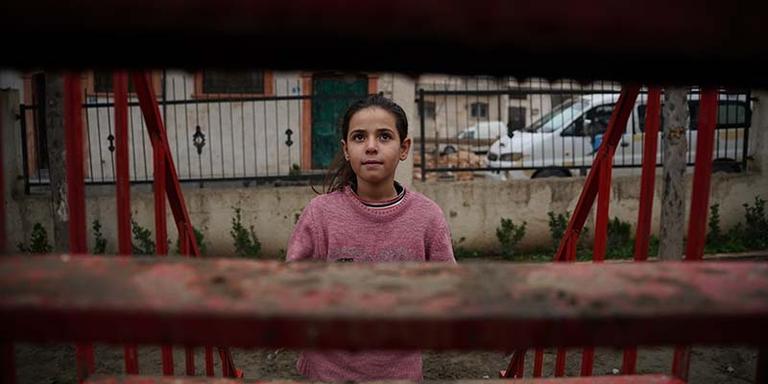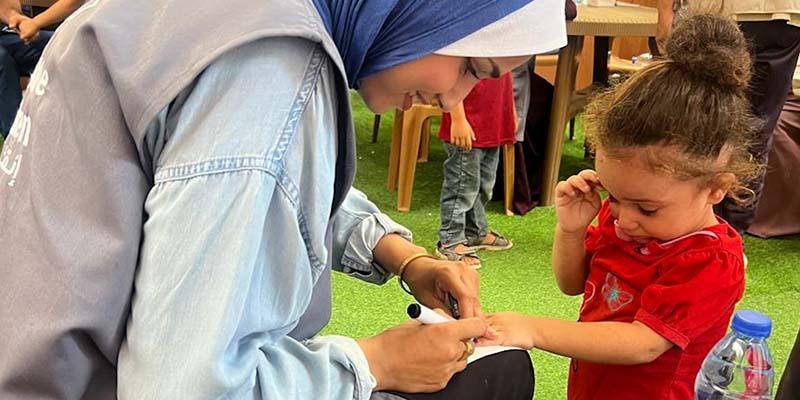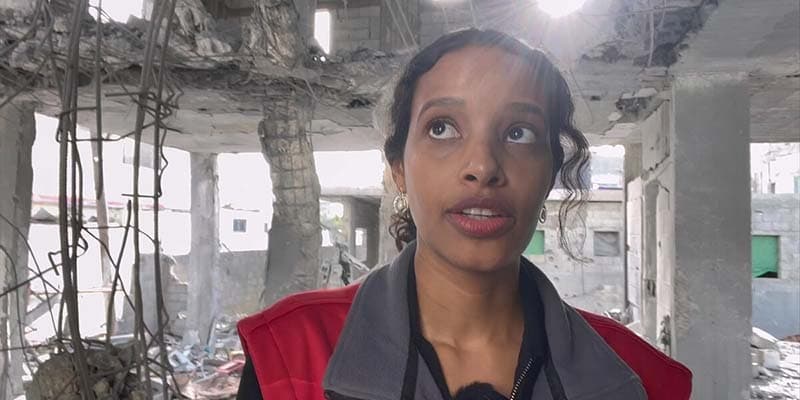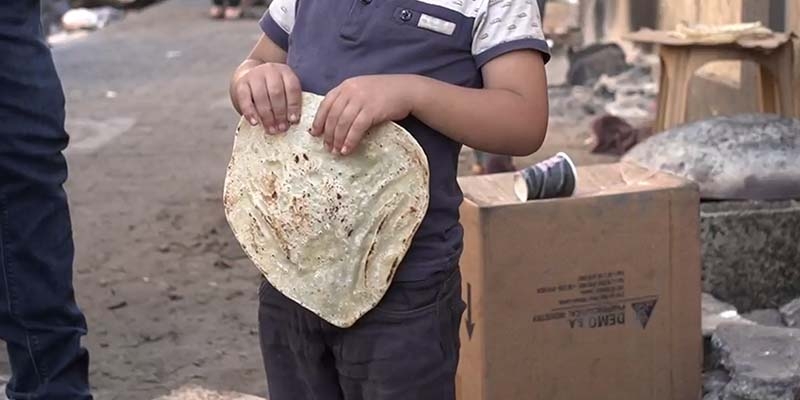
11-year old Samar* has been unable to attend school in Syria following the deadly 2023 earthquakes.��However, Save The Children, in collaboration with partner organization Bonyan, has re-established a nearby playground and worked to enroll her in upcoming educational projects.��
One Year On: Syria's Post-Earthquake Struggles
By��Rasha Muhrez, Country Director for the Syria Response Office
When the earthquakes hit Türkiye and Syria last year,, the question in the minds of many Syrians, myself included, was: "Could things get any worse?" Unfortunately, the answer appears to be a resounding yes.��
Take my cousin 16-year-old Naya. Her social media posts over the past year have been a constant stream of all-black images and broken-heart emojis as she struggles to move on. Naya lost her 18-year-old sister Maya in the earthquake.��
In my hometown of Jableh, our family’s home collapsed, killing two of my teenage cousins and three other members of the family.�� In the initial hours and days following the earthquake, the world turned their back on Syrians, with slow search and rescue.����
The dire circumstances in the country made things even harder. It took my family hours to reach the scene, a struggle shared by many who, like us, didn’t have access to a car or fuel. On that cold, dark winter morning, neighbours rallied to clear the debris with their bare hands. The rescue teams arrived just moments too late. My cousins' bodies were still warm when unearthed.����
I was left asking myself if the devastation would have been as bad if the conflict had never happened. If services were better, would my young cousins still be alive?��
Fast forward one year, and the situation in Syria has worsened.����
The number of people requiring humanitarian assistance has surged from 15.3 million to 16.7 million in the last year, the highest since the start of hostilities about 13 years ago, according to the .��The irony is now, as humanitarians we are asked to provide assistance to more people with less funding. We are told to prioritise - to choose between preventing starvation or sending children to schools.��
Having spent 16 years working in conflict zones globally, predominantly with Save the Children, I’m truly fearful for the next generations of Syrians. Solutions are dwindling, while needs have skyrocketed.����
Conflict, Climate and Crumbling Economy
In the 12 months following the earthquake, the country has faced a trifecta of challenges: renewed conflict, climate change, and a crumbling economy. The most significant escalation in conflict in five years hit northern Syria in October, and regional in January pose additional threats, especially to children. Around one third of households said children showed signs of mental distress,
The ongoing economic crisis, worsened by sanctions, has made life unbearable for ordinary Syrians. The year 2023 marked the worst for the currency, with skyrocketing inflation transforming basic necessities into luxuries.��
A staggering 90% of households struggled to cover essential needs, leaving families to make impossible decisions for their children,
“We are barely surviving... everything has become expensive,” explained Zaina*, a mother of six, living in an informal camp in Raqqa supported by Save the Children.�� ��
“We don't have money to buy wood. We have no choice but to walk in the streets to collect plastic and anything that we can burn to warm ourselves,” she explained.����
Too many families, like Zaina’s, face the agonising reality - deciding between putting food on the table or heating their homes. It’s an impossible choice as people brace for the annual harsh winter storms and floods.����
This comes after a year marked by erratic rainfall and extreme heat, linked to climate change, which triggered devastating wildfires across the country in July.��
More Need, Less Aid
Just as needs have gone up, aid has gone down.�� ��
The World Food Programme (WFP) stopped much of its main food assistance programme in the country at the start of this year due to a lack of funding.����
Financial support for Syria is decreasing as other urgent crises dominate headlines. But beyond the money, international attention on the crisis is also fading, prompting my greatest fear: will the world forget about Syrians?
Syria - the country - remains a battleground for global powers. But Syrians - the people - are too often overlooked.����
Following the tragic deaths in my family, I addressed the UN Security Council last year urging the international community to use the earthquakes as a moment to reevaluate our approach to Syria.����
As both a Syrian and a humanitarian, I warned that the earthquake could push the country to the brink, leaving the next generation dependent on aid.����
I asked whether simply keeping children alive, without addressing the root cause, would be enough?�� The answer was clear, but things are yet to change.������
��
Children at a Breaking Point
Many children, like my cousin Naya, are reeling from the double-blow of conflict and earthquakes.����
Returning to school after the loss of her sister, she has few avenues for support. There’s almost no mental health support available for young people, despite almost 70% of children struggling with sadness, according to a survey by Save the Children. Over half of healthcare workers, including qualified mental health professionals, have left the country over the past decade, according to the UN.
"I still feel the ground shaking," one eight-year-old boy in northern Syria told our staff, "It's not just the earthquake that scares me—dozens of bombs fell on our camp."����
The boy’s father died in a bombing before the earthquake. His mother lives off aid, with barely enough money to buy bread. She says he’s become more and more withdrawn, living in constant fear for his life.����
Many areas hit by the earthquake had been focal points of conflict in the last five years, but the earthquake ignored conflict lines. It devastated communities already struggling to cope. It impacted people already at breaking point - mentally, physically and financially.��
Driving through Syria last year, I saw hundreds of people forced into shelters with no heating or electricity after the earthquake. People who survived the earthquakes and already had next-to-nothing were having to help others.
The earthquake's impact is undeniably linked to the almost 13-year-long conflict. Many buildings, already partially damaged from conflict, crumbled too easily. Houses with no foundations and visible bullet holes, schools near-destroyed from fighting. Areas were more densely populated, following mass displacement, leading to more deaths.����
Nobody can prevent natural disasters, but we can and must improve our response.��
What Future?
The earthquakes forced the world to pay attention to Syria again. It was an opportunity for meaningful reflection and change.����
The path forward remains clear - we need to restore basic services in Syria. Beyond rehabilitating damaged or dilapidated infrastructure, we need to create safe spaces and schools for children, train teachers and pay them a proper wage for their job.��
We need investment in sustainable projects focused on supporting parents to access jobs that pay a decent wage, support farming so people are less reliant on food assistance, and health systems so children can grow up healthily. We have to ensure that children and their families can access proper mental health support so they can cope with everything they have been forced to endure.����
Right now, there’s nowhere near enough funding or support to achieve this.�� ��
Our work as humanitarians has never been harder. There’s no momentum for a peaceful way forward. Yes, we need financial assistance, but we also need the people giving us money to allow us to make change. We simply cannot keep doing the same things, with fewer resources and expect to see a better outcome for children.����
The world is of course a more fragile place today than it was a year ago, and Syria is among a growing number of countries grappling with conflict, particularly in the region.����
But the international community has a responsibility to ensure that all children, wherever they are, can grow up in safety, in dignity and in hope.����
Only through collective action, sustained support, and a commitment to meaningful change can we hope to build a better future for Syria.����
As we remember the earthquakes that shook our world, let us not forget the ongoing struggle of the Syrian people.������



